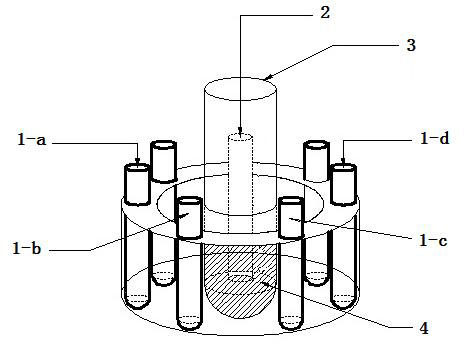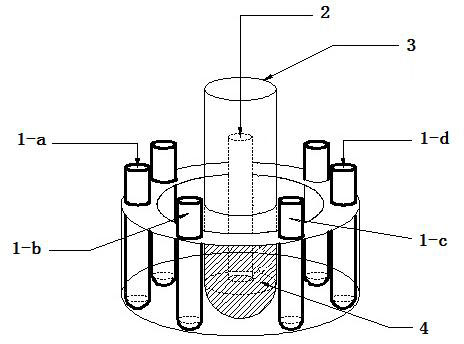Method utilizing small-molecule diketone to serve as optical active agent for oxidation treatment of dye waste water
A technology of dye wastewater and photoactive agent, which is applied in oxidation water/sewage treatment, light water/sewage treatment, textile industry wastewater treatment, etc., can solve the problems of large consumption of reagents, poor reaction selectivity, low decolorization efficiency, etc. Efficient and fast decolorization effect
- Summary
- Abstract
- Description
- Claims
- Application Information
AI Technical Summary
Problems solved by technology
Method used
Image
Examples
Embodiment 1
[0027] Filter the dye-containing wastewater to remove suspended matter; then fill 25 ml of 2,3-butanedione aqueous solution containing 0.2 mM Orange II and 1 mM into a quartz test tube with an inner diameter of 2 cm 1-a , put 25 ml of aqueous solution containing 0.2 mM orange II and 1 mM 2,5-hexanedione into a quartz test tube with an inner diameter of 2 cm 1-b , 25 ml containing 0.2 mM Orange II and 1 mM H 2 o 2 The aqueous solution was filled into a quartz test tube with an inner diameter of 2 cm 1-c, Place the quartz test tube parallel to the 300 W medium pressure mercury lamp 2 Axial orientation position placement, mercury lamp 2 cooling water jacket 3 Medium, quartz test tube distance from mercury lamp 2 The distance is 6 cm. Turn on the mercury lamp 2 Preheat for 5 minutes, the intensity of radiation received by the quartz test tube is 4 mW / cm at 365 nm 2 , to remove the mercury lamp 2 Light shield between the quartz test tube 4 , quartz test tube around mercur...
Embodiment 2
[0029] The irradiation device and irradiation conditions are the same as in Example 1, except that 2,3-butanedione, 2,5-hexanedione and H 2 o 2 The concentration is 0.5mM, into the quartz test tube 1-a, 1-b 1 mM 1,4-cyclohexanedione and 1,4-benzoquinone (also known as cyclohexa-2,5-diene-2,4-dione) were added to the 1-a, 1-b The absorbance of the solution in 484nm did not decrease significantly.
[0030] This example shows that not all diketone compounds can promote dye decolorization, that is, the small molecule diketone involved in this patent has certain structural characteristics.
Embodiment 3
[0032] The irradiation device and irradiation conditions are the same as in Example 1, except that 2,3-butanedione, 2,5-hexanedione and H 2 o 2 The concentration is 0.5mM, into the quartz test tube 1-a , 1-b and 1-c Add 0.5 mM ethanol to the quartz test tube 1-a and 1-b( UV / diketone system ) The decolorization rate of the solution in the quartz test tube is constant. 1-c ( UV / H 2 o 2 control group ) The decolorization rate of the solution in the solution was reduced by 32%.
PUM
 Login to View More
Login to View More Abstract
Description
Claims
Application Information
 Login to View More
Login to View More - R&D
- Intellectual Property
- Life Sciences
- Materials
- Tech Scout
- Unparalleled Data Quality
- Higher Quality Content
- 60% Fewer Hallucinations
Browse by: Latest US Patents, China's latest patents, Technical Efficacy Thesaurus, Application Domain, Technology Topic, Popular Technical Reports.
© 2025 PatSnap. All rights reserved.Legal|Privacy policy|Modern Slavery Act Transparency Statement|Sitemap|About US| Contact US: help@patsnap.com


